Books
Books

Ventoline #4 – mai 2022
Ventoline est un fanzine né à la fois d’un enthousiasme quotidien pour ce qui se rapporte à la musique, et d’une véritable lassitude face à la quasi-absence de paroles féminines autour de ce vaste sujet. Commenter, critiquer, prescrire, partager ses histoires, ses goûts, ses dégoûts, en somme, sa culture musicale… Pourquoi si peu de femmes s’autorisent à le faire? Même lorsqu’elles programment, organisent, sonorisent des concerts, lorsqu’elles mixent tous les week-ends, pogotent au premier rang, lorsqu’elles sortent des disques, dessinent des affiches et récurent les tréfonds de Soulseek. Même lorsqu’elles produisent et consomment de la musique.
Le but de ce fanzine ne sera ni d’émettre des classements, ni de théoriser savamment afin d’être prises au sérieux. La musique nous a construites personnellement et socialement, il s’agira donc de partager nos expériences liées à elle —heureuses comme foireuses—, nos observations, nos fantasmes, nos figures tutélaires. Ce que ça fait, entre autres, de tourner pendant un mois dans un van, de passer pour la potiche de service ou de se prendre une claque au détour d’une compile. De Portland à Barcelone, en passant par Paris, Marseille, Bruxelles, Lyon et Leipzig, une douzaine de mélomanes polymorphes ont prêté leur voix à ce premier numéro de Ventoline.
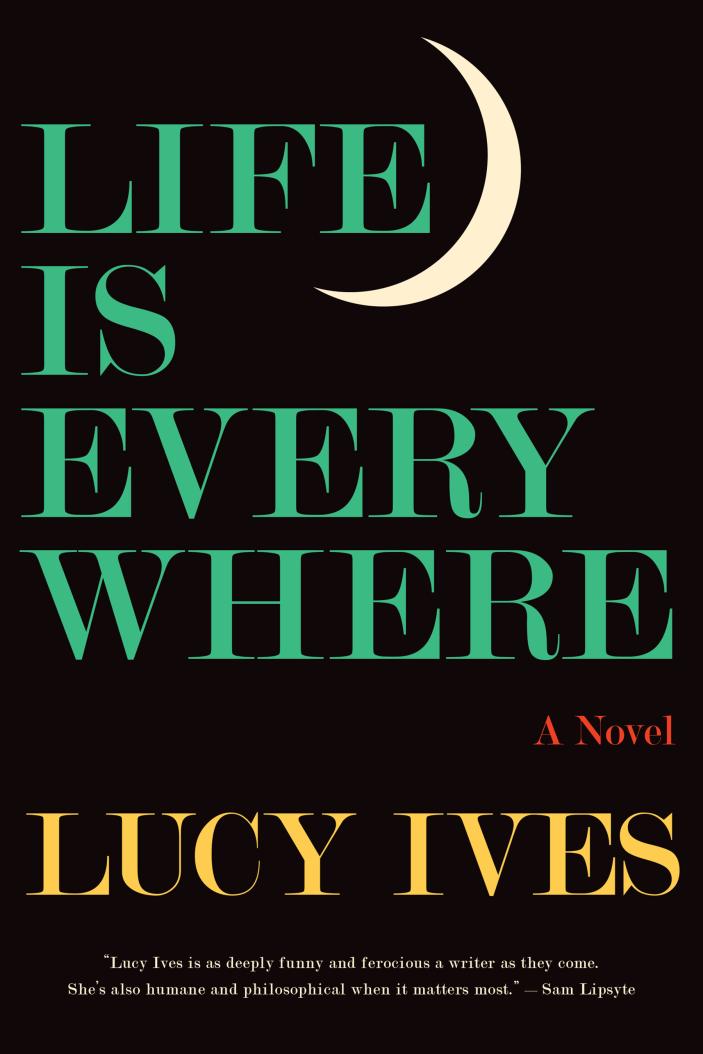
Life Is Everywhere
Everything that happened was repetition. But it was repetition with a difference. So she dragged along in a spiral, trusting to this form.
Manhattan, 2014. It’s an unseasonably warm Thursday in November and Erin Adamo is locked out of her apartment. Her husband has just left her and meanwhile her keys are in her coat, which she abandoned at her parents’ apartment when she exited mid-dinner after her father—once again—lost control.
Erin takes refuge in the library of the university where she is a grad student. Her bag contains two manuscripts she’s written, along with a monograph by a faculty member who’s recently become embroiled in a bizarre scandal. Erin isn’t sure what she’s doing, but a small, mostly unconscious part of her knows: within these documents is a key she’s needed all along.
With unflinching precision, Life Is Everywhere captures emotional events that hover fitfully at the borders of visibility and intelligibility, showing how the past lives on, often secretly and at the expense of the present. It’s about one person on one evening, reckoning with heartbreak—a story that, to be fully told, unexpectedly requires many others, from the history of botulism to an enigmatic surrealist prank. Multifarious, mischievous, and deeply humane, Lucy Ives’s latest masterpiece rejoices in what a novel, and a self, can carry.
[note from the publisher]

And then it got legs: Notes on dance dramaturgy
Drawing on his experience in the field of contemporary dance, Jeroen Peeters discusses principles, methods and practices that contribute to an understanding of dramaturgy as an experimental, collaborative practice and a material form of thinking.
Written from practice, this book reflects a particular history of collaboration and conversation with dance-makers such as Martin Nachbar, Meg Stuart, Vera Mantero, Sabina Holzer, Lisa Nelson, Jennifer Lacey, Chrysa Parkinson, deufert + plischke, Eleanor Bauer, Philipp Gehmacher and many others.
Phantasmal archaeology, unfolding material, literal and physical reading, crafting method, articulating process, witnessing and performing not-knowing, naming and ritual destruction, conceptual landscapes, symbolic waste, internal fictions and foreign objects – they may all play a role in creation and in exploring the unfamiliar in pursuit of making sense.
And then it got legs is an invitation to think along or against, to discuss those ideas with others or explore them in the studio, and eventually to imagine and devise one’s own methods of research, observation, reflection and creation.

Press & Fold — Notes on making and doing fashion
This Press & Fold issue on Resistance presents conversations, propositions and imaginations of fashion and resistance outside of fashion’s industrial context. For protest and resistance to become effective, it depends on community to generate, support and further it: with this issue we think further on these ideas of protest, activism and resistance in and around fashion, and not only in terms of clothing, and how it is portrayed in (fashion) imagery, but also in terms of how fashion is structured and organized: is fashion only able to thrive within a capitalist structure, or are there other possibilities as well? What ideas, initiatives and structures can be developed for fashion to become inclusive and generous to all participants? What needs to be resisted and what needs to be embraced? In that sense this issue of Press & Fold, as well as the previous issues, is a world-building exercise, and wants to show what we can do without, and what we need to move fashion towards becoming a generous to all participants involved?
— Note from the publisher
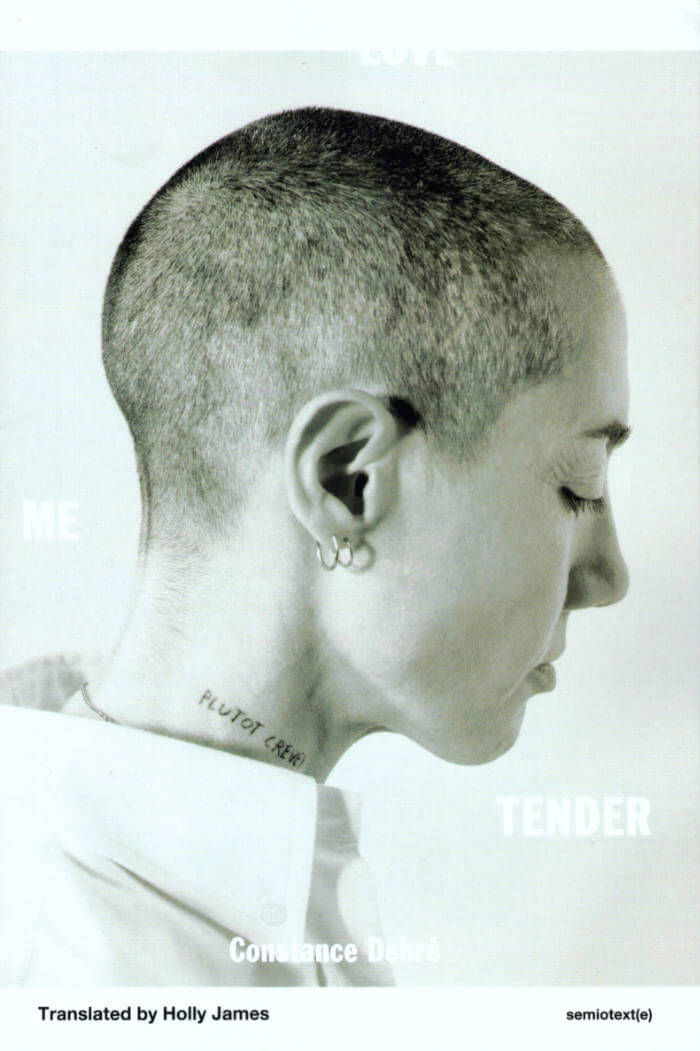
Love Me Tender
A novel of lesbian identity and motherhood, and the societal pressures that place them in opposition.
The daughter of an illustrious French family whose members include a former Prime Minister, a model, and a journalist, Constance Debré abandoned her marriage and legal career in 2015 to write full-time and begin a relationship with a woman. Her transformation from affluent career woman to broke single lesbian was chronicled in her 2018 novel Play boy, praised by Virginie Despentes for its writing that is at once "flippant and consumed by anxiety."
In Love Me Tender, Debré goes on to further describe the consequences of that life-changing decision. Her husband, Laurent, seeks to permanently separate her from their eight-year old child. Vilified in divorce court by her ex, she loses custody of her son and is allowed to see him only once every two weeks for a supervised hour. Deprived of her child, Debré gives up her two-bedroom apartment and bounces between borrowed apartments, hotel rooms, and a studio the size of a cell. She involves herself in brief affairs with numerous women who vary in age, body type, language, and lifestyle. But the closer she gets to them, the more distant she feels. Apart from cigarettes and sex, her life is completely ascetic: a regime of intense reading and writing, interrupted only by sleep and athletic swimming. She shuns any place where she might observe children, avoiding playgrounds and parks "as if they were cluster bombs ready to explode, riddling her body with pieces of shrapnel."
Writing graphically about sex, rupture, longing, and despair in the first person, Debré's work is often compared with the punk-era writings of Guillaume Dustan and Herve Guibert, whose work she has championed. As she says of Guibert: "I love him because he says I and he's a pornographer. That seems to be essential when you write. Otherwise you don't say anything." But in Love Me Tender, Debré speaks courageously of love in its many forms, reframing what it means to be a mother beyond conventional expectations.

Suckcess Magazine 1 — Winter 2021-22
Drama, careers, sabotage, compromises... The first issue of Suckcess Magazine begins with a selection of poems by the flamboyant Rene Ricard, edited with the help of Editions Lutanie, and continues with contributions from Miriam Laura Leonardi, Fabienne Audéoud, Camille Aleña, Gabi Losoncy, David Lieske, Sylvie Fanchon, Won Jin Choi, Estelle Hoy, and Bunny Rogers. Cartoons and tennis players are also on the program.

She didn't say it was her phone, she said her girlfriend heard a phone ringing
The volume is an epistolary narrative produced via text message with a community of anonymous correspondents. Following on from a performative work, conceived by Simon Asencio, this book stages a relation between two protagonists, U and I. Through identitarian slips and glyphs, the book explores the narrative ambiguities of experimental writing, to generate a space for fluidity and uncertainty, at the intersection of the artistic and the literary.
Edited by Lilou Vidal
Dear reader,
These words are the premises of a correspondence between you and I. It will carry on for some a few days or a few months, it's up to you-just tell me if you want ti bring this to an end. One part of this story has ended on April 19th, 2020. Another part continues within these bound pages.
U and I don't jnow each other: two letters standing in for two characters in a story yet to be narreted.
You will remain forever the riddle, an address to the unknown: I will be writing to U, unknowing of who stands behind this U (after all you could be so many), unknowing of where you stand when reading these words, unknowing of how these words might coalesce with the life that forges your sense of self daily.
In my case this I might not necessarily stand for one self either, yet I will account for all of these selves.
I hope this masquerade will allow us to get closer. To long for and attend to each other without assuming our otherness.
I do not expect any answers. Yet if you do, I promise it will remain between U and I.
I look forward x
+32 485 837 930
Simon Asencio (Toulouse, 1988) uses imposture and the expression of doubt to create performances that question the notions of liveness, stage and audience. The publication of this book results from the exhibition This Is My Body, My Body Is Your Body, My Body Is the Body of the Word, curated by Lilou Vidal, at Le Delta, Namur (BE); in partnership with Le Delta, Namur, with the support of Fédération Wallonie-Bruxelles.

Poster Edition (bundle)
4 poèmes-affiches, format A3, impriméx en risographie au studio Colorama (Berlin), sur papiers variés, tirage à 150 exemplaires
«GASOLINE, Apocalypse 1998», «the category is: phone sex», «zona nudista», «(fête) sentimental-e-s» : étés d'apocalypse, émojis banane, cruising transocéanique, SMS en short, sales coeurs, baraques à frissons et grand-huit sentimental... ces poèmes courent toustes ~ à genoux, à nu ou en solex ~ après la question du désir, après l'amour aussi, avec une tendre obsession
Design graphique signé Auriane Preud’homme, Enz@ Le Garrec, Roxanne Maillet & Martha Salimbeni, avec des dessins de Gaëlle Loth

Poster Editions (single)
4 poèmes-affiches, format A3, impriméx en risographie au studio Colorama (Berlin), sur papiers variés, tirage à 150 exemplaires
«GASOLINE, Apocalypse 1998», «the category is: phone sex», «zona nudista», «(fête) sentimental-e-s» : étés d'apocalypse, émojis banane, cruising transocéanique, SMS en short, sales coeurs, baraques à frissons et grand-huit sentimental... ces poèmes courent toustes ~ à genoux, à nu ou en solex ~ après la question du désir, après l'amour aussi, avec une tendre obsession
Design graphique signé Auriane Preud’homme, Enz@ Le Garrec, Roxanne Maillet & Martha Salimbeni, avec des dessins de Gaëlle Loth

From Scratch – Albanian Summer Picaresque
Dave Smith, Jan Steele and 1 more
An account of an album about Albania by British experimental musicians made in the eighties. Also involving stories about the Albanian Society, William Bland, A. L. lloyd, RCPB ML, and Cornelius Cardew.
From Scratch is a story of Albanian Summer: An Entertainment, an LP album released by Practical Music in London in 1984. The album was composed by Dave Smith—English experimental composer and musician, figure of the British minimalist scene, explorer of Javanese and Albanian musical traditions with the English Gamelan Orchestra and Liria which he co-founded, and a member of The Scratch Orchestra (with Brian Eno, Cornelius Cardew, John Tilbury, Keith Rowe, Michael Nyman, Michael Parsons, etc.)—, and performed by Janet Sherbourne and Jan Steele, improvised and classical musicians.
Through interviews, archival materials, and hard-to-find essays the publication contextualizes the background of British experimental musicians' interest in socialist Albania. It includes new interviews with Dave Smith and Jan Steele, three essays by Smith on Albanian music and culture, an essay by Gavin Bryars on Smith's music, discussions on the influence of A.L. Lloyd and Cornelius Cardew, and the role of the Albanian Society in the UK. The book introduces new insight into the leftist internationalist background of British experimental music influenced by the work of Cardew.
Apart from the musical internationalism, the book also includes a section of nine abstract slogans depicting the political and artistic contradictions of socialist Albania; annotated bibliography of books published in different languages on Albania; the collection of images taken from the biweekly Zëri i Rinisë (The Voice of Youth) published in 1984 and 1985.

Three Moral Tales
Joëlle de La Casinière, Ana Jotta and 1 more
The moral tale is a literary genre that was especially popular in Europe throughout the 18th century. As ways of being and doing were strongly tied to conventions assigned to social roles and genres, the rise of rationality and freethought, characteristic of this era, began re-organizing the so-called “natural order” of established patterns. Through fables and satires, moral tales expressed sharp critical views on the social relationships and hierarchies of the time, often using radical irony and cruelty, as in the tales of Jonathan Swift or of the Marquis de Sade, to decipher the untold rules at play in this early age of capitalism.
The works of the three artists invited to these Three Moral Tales are not that of moralists, but somehow assume a kind of moral dimension, as they present themselves as critical allegories. Joëlle de La Casinière, Ana Jotta and Anne-Mie Van Kerckhoven make use of fables and sometimes caricatures to observe and criticize the cruelty of human relationships. The “moral tales” narrated by these three artists scrutinize representations of evil, and mock hierarchies, traditions and social order. By doing so, they also follow up on a certain spirit of the iconoclastic avant-gardes of the early 20th century.
French artist Joëlle de la Casinière, Portuguese Ana Jotta and Flemish Anne Mie Van Kerckhoven have in common to pay no fealty to trends of contemporary art. Moreover, they fought unwaveringly throughout their respective careers the need to see their work being given an “official line”. Instead, they stood aside, went underground or remained indifferent to the twists and turns of the art market and institutions. They sometimes created surrogate characters, hid, or playfully modified their names to react to the branding of identity in the artworld, and to the imposed marginalization that they had to cope with as women artists, as did artists living in peripheral geographies. In a way, paradoxically, being marginalized encouraged a calculated versatility of media and styles, and the invention of an idiosyncratic vocabulary, while total freedom remained their one and only rule.
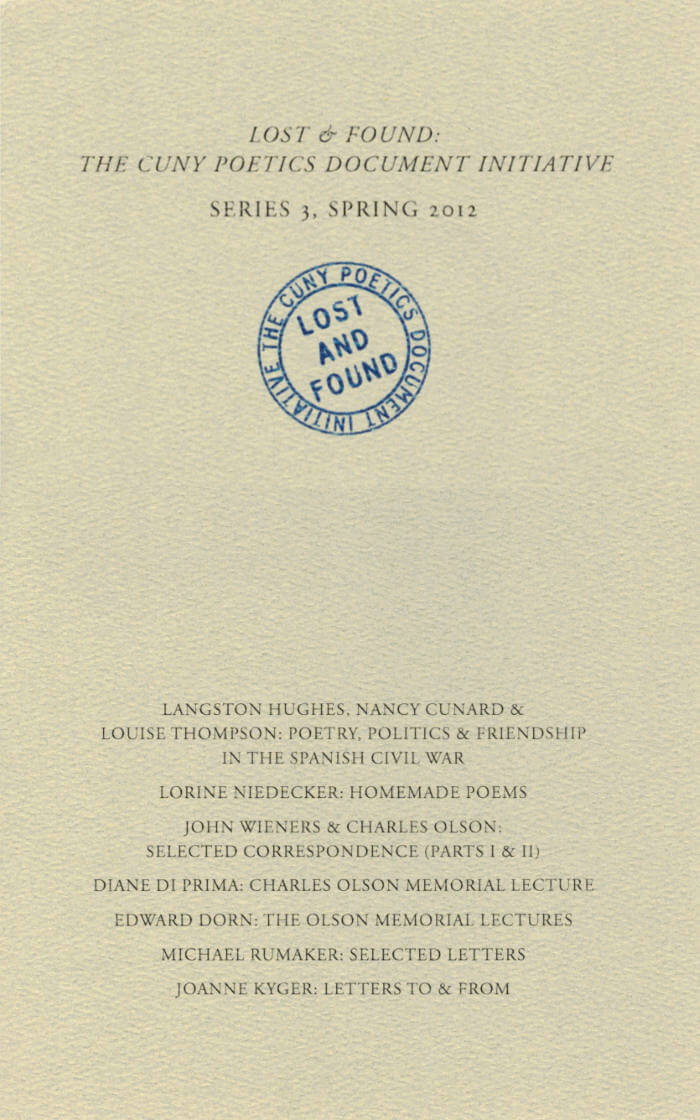
CUNY Center for the Humanities
Lost & Found: The CUNY Poetics Document Initiative, Series III
John Wieners, Lorine Niedecker and 3 more
Lost & Found: The CUNY Poetics Document Initiative publishes unexpected, genre-bending works by important 20th century writers. Unearthed from personal and institutional archives in the United States and abroad, these materials are edited by doctoral students at the Graduate Center, CUNY.
SERIES III is a collection of 8 chapbooks that authenticate Edward Dahlberg's claim that "There is more political energy in friendship than in ideology."
Langston Hughes & Nancy Cunard cement their personal relationship by penning notes across the ocean throughout the Spanish Civil War. After meeting at Black Mountain, John Wieners & Charles Olson remain in close correspondence until months before Olson's death. In "Old Father, Old Artificer," part lecture and part evocation of Charles Olson, Diane di Prima helps to establish how key figures in "New American Poetry" were processing their own past, while the breathless Olson lecture by Ed Dorn erodes the fictive dualism that pits poetic theory against practical action. In his letters, Michael Rumaker invites you to share his life, its radiant pursuit of love, "dirty realism," literature, and lasting community, and Joanne Kyger booms "communication is essential" in her Letters to & from. In Homemade Poems, a gift-book mailed to a friend in 1964, Lorine Niedecker insists that the handmade chapbook is the material continuation of the poems so carefully nestled in its pages.
Breaking up the monolith of the historical lens, Series III continues to track individuals as they tell their stories, cast their lifelines, and position themselves in relation to the times they lived in—and the times we live in—through intimate journals, letters, lectures, and friendships. Edited, annotated, and with accompanying essays, The London Review of Books calls this "a serious and worthy enterprise." Diane di Prima calls the series "a gold mine" and Joanne Kyger writes: "What a brilliant cast of characters. Just exactly what one (myself) would like to read."
SERIES III includes:
Lorine Niedecker: Homemade Poems (John Harkey, editor)
John Wieners & Charles Olson: Selected Correspondence (Parts I & II) (Michael Seth Stewart, editor)
Diane di Prima: Charles Olson Memorial Lecture (Ammiel Alcalay and Ana Božičević, editors)
Edward Dorn: The Olson Memorial Lectures (Lindsey Freer, editor)
Michael Rumaker: Selected Letters (Megan Paslawski, editor)
Letters to & from Joanne Kyger (Ammiel Alcalay and Joanne Kyger, editors)
Langston Hughes, Nancy Cunard & Louise Thompson: Poetry, Politics & Friendship in the Spanish Civil War (Anne Donlon, editor)

Serving Compressed Energy With Vacuum
Published in conjunction with an exhibition at Kunstverein München, this catalogue is presented as an integral part of the show, augmenting it through the presentation of subjects, aspects, and themes which are better suited to the printed medium or demand another kind of involvement. Anne-Mie Van Kerckhoven’s works involve painting, drawing, digital media, and video, and reflect her fascination from a female point of view with the representation of women in mass media, the connections between sex and technology, different knowledge systems, and the unconscious. Besides numerous works, projects, and images, the book includes insightful explanations by the artist.

Fieldguides for a Preternaturalist 3
‘Fieldguides for a Preternaturalist’ is a series of small chapbooks designed to bring collaborators, audiences, and readers together as part of the project ‘Nothing of Importance Occurred: Recuperating a Herball for a 17th-Century Enslaved Angolan Midwife at the Cape’, initiated by South African artist Wendy Morris. Through speculative investigations of plants-as-archive and storytelling-as-method, the project focuses on retrieving a library of botanical-medicinal knowledge that perhaps informed Morris’s enslaved ancestor. The ‘Fieldguides’ invite collaborators to shed light on this from multiple angles. Joshua Cohen and Johanna Lot are the guest contributors of the third edition.

Requíem for Mirrors and Tigers
Naufus Ramírez-Figueroa: Requiem for Mirrors and Tigers catalogues the trajectory of a cycle of performances of the same name, through which the artist Naufus Ramírez-Figueroa attempted to exhaust his interest in the Guatemalan Civil War as a recurring subject of his work. Designed by Studio Manuel Raeder and published by If I Can’t Dance with Bom Dia Books, the publication documents the six performances in the cycle via foldout colour posters of each work, and an essay by Frédérique Bergholtz and Susan Gibb which offers descriptions of each performance alongside a reflection on the cycle as a whole.
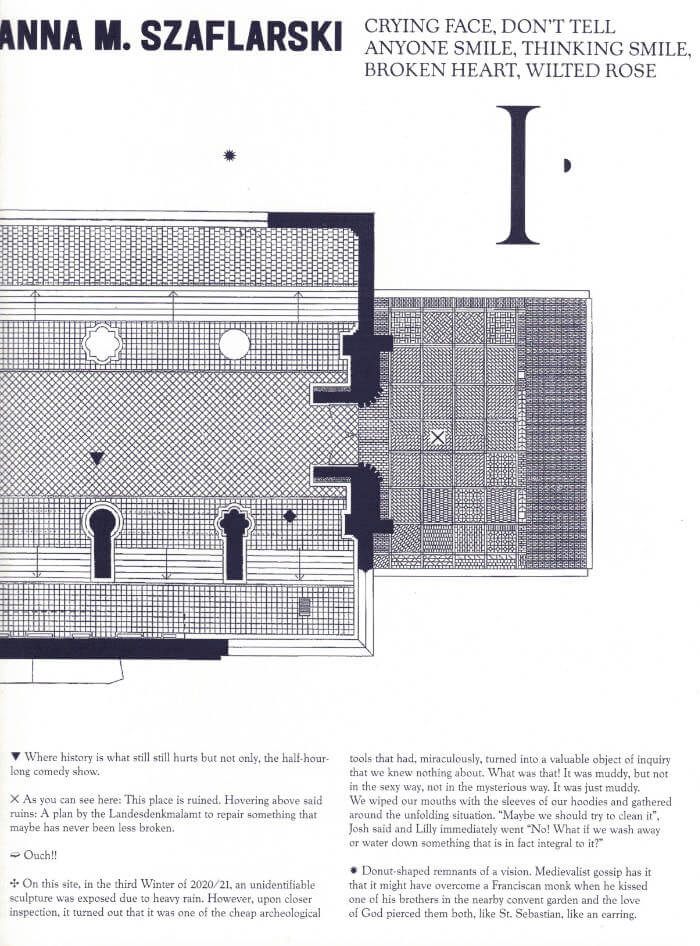
Klosterruinenzines
Anna M. Szaflarski, Simone Fattal and 2 more
Four zines, documenting and continuing a series of four exhibitions that took place last summer, also known as the summer of 2021 at Klosterruine Berlin. Digging up what’s always already left behind, this series reframes the exhibition as an excavation site and engages archeology as a speculative and aesthetic procedure. A map, a notebook, a calendar and a dream diary, these four zines allow you to become your own archeologist.
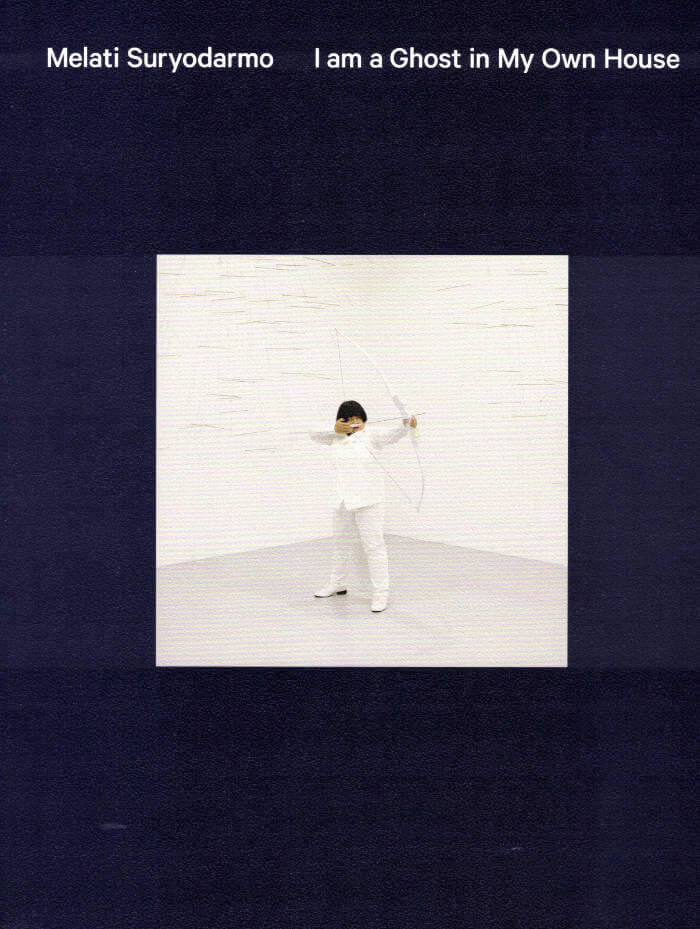
I am a Ghost in My Own House
First monograph on the durational performance artist Melati Suryodarmo, one of the pioneers of performance art in Indonesia.
Published on the occasion of the presentation of the Bonnefanten Award for Contemporary Art, BACA 2022, to Melati Suryodarmo, and in conjunction with her solo exhibition at the Bonnefanten Maastricht in 2022.
Melati Suryodarmo (born 1969 in Surakarta, Indonesia) is a versatile artist, but is particularly known for her compelling performances. Suryodarmo's performances reflect her own ideas and cultural background, and concern the relationship between the human body, the defining cultural traditions to which the body belongs and the context in which it lives. She focuses on concepts like home, spirituality, family and personal history, interweaving them with socio-political, activist and mainly feminist ideas.

Shell Reader
Literally crumbling under our own weight, several metric tonnes of shells speak up from the ground, causing a sensation remote from that of walking on a gallery floor. Yet, crushed calcite from marine molluscs is an essential ingredient in concrete, a major constituent of our built environment. In Muscle Memory, a sculpture by Nina Canell, the biomineral forms that feed the construction industry gradually break down over the course of the exhibition. Material stress gives way to a sounding, durational sculpture, inviting us to consider the ineffable number of broken bodies that holds us up. Shell Reader calls on the material vitality of calcium carbonate, detailing broken pieces of shell from Muscle Memory. By foregrounding these fragments, each page echoes a crack, snap, split, or splinter.
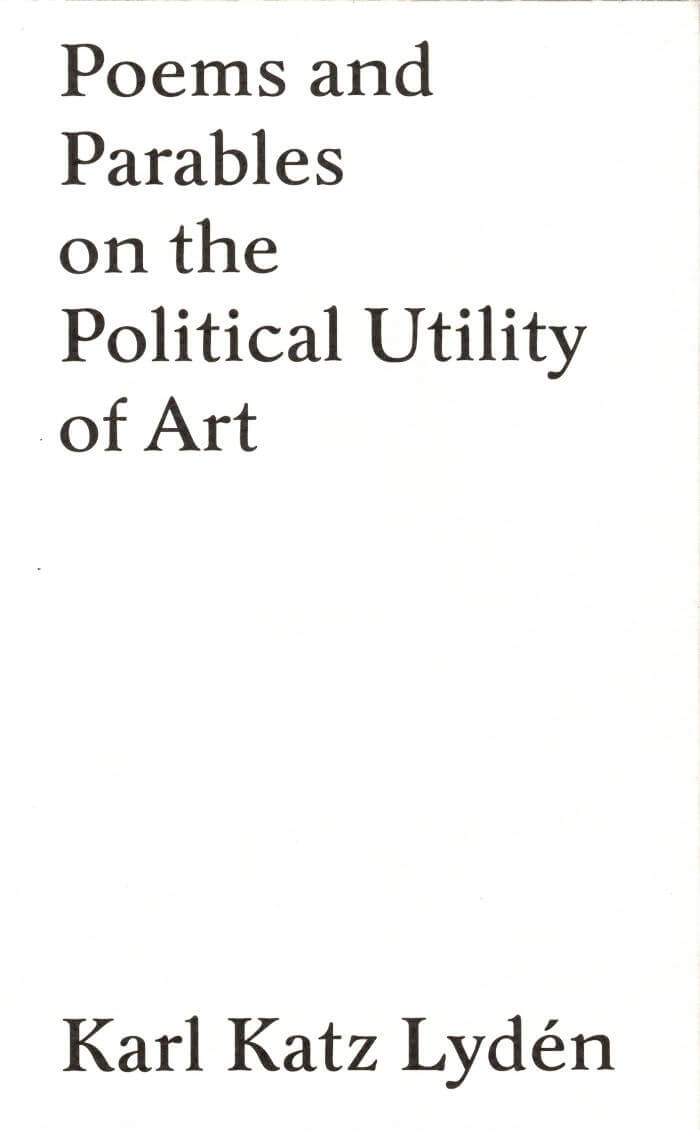
Poems and Parables on the Political Utility of Art
Like a donkey dressed in zebra’s clothing, criticism can appear in a borrowed coat; perhaps it can even reveal itself in stolen poems. Here, among fables of donkeys, shoemakers and barricades, German angels and non-German angels, and a few lines from Emily Dickinson, the transformative possibilities of art are unfolded in the figure of labor.
Poems and Parables on the Political Utility of Art is a small book. It looks like poetry, but it is better described as a kind of criticism. Taking up some recent disqualifications of art’s political potential, it refutes them in a threefold movement: against the notion of commodification of works of art; against the act of denouncing art as always-already reified from the safe position of a pure, untouched theory; against the notions that art must either reveal our alienation, or produce immediate effects on the social sphere. Outlining art’s transformative possibilities in the figure of a certain labor, the argument is shaped among fables of donkeys, zebras from Gaza, apes from Adorno, and a particular barricade from the Paris Commune.
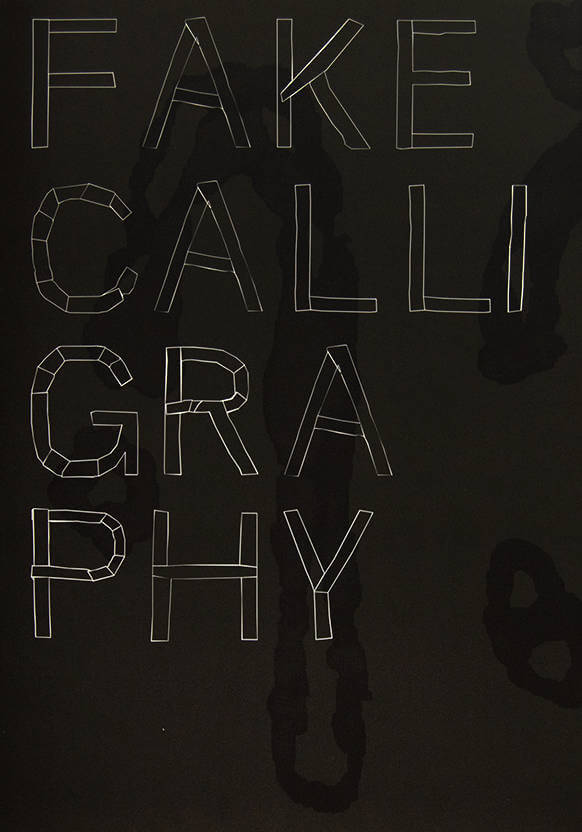
Fake Calligraphy
Ada Van Hoorebeke, Maartje Fliervoet and 1 more
Fake Calligraphy is a mobile sculpture consisting of a simple set of metal frames, batik, and tools that are used in repeated collective performances. The sculpture serves as a workshop where patterns based on pseudo-writing are collectively produced. The publication documents a joint making process along with some of the techniques that are applied here, such as dyeing with natural dyes and wax batik.
Fake Calligraphy is an ongoing work made by many participants, developed and facilitated by Ada Van Hoorebeke, Maartje Fliervoet, and the artistic platform manoeuvre. Amongst other places Fake Calligraphy was performed and shown at WIELS Contemporary Art Centre, Brussels, Kunsthal Gent, (Ghent) and at homes and studio’s of contributors in Ghent, Serekunda, Brussels, The Netherlands, and Berlin.
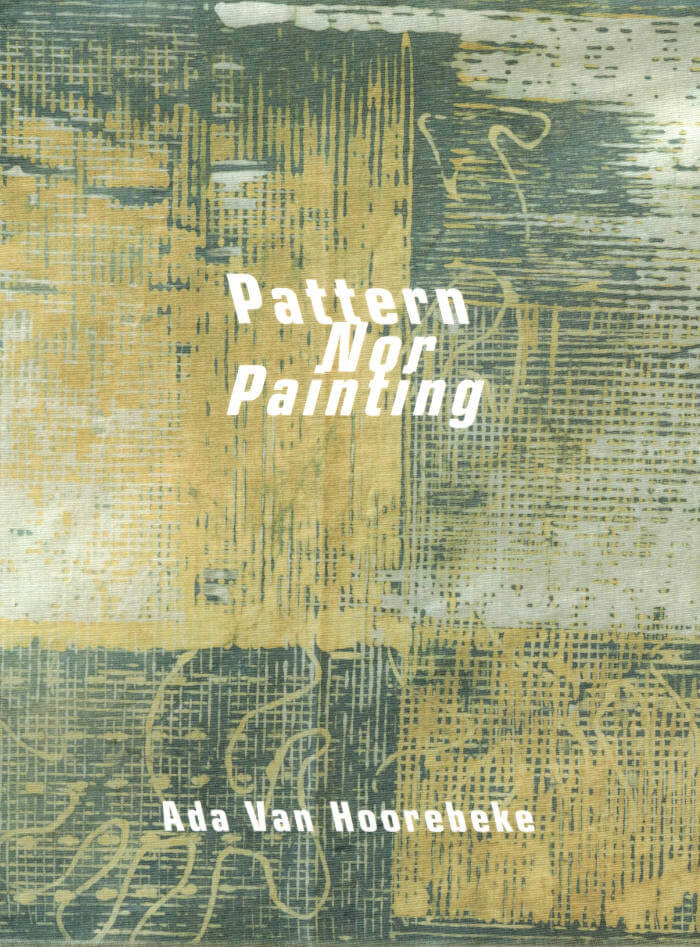
Pattern Nor Painting
The motifs produced during time-intensive dyeing processes – which uses indigo, urine, and extracts of natural waste materials – are neither conventional fabric nor lace patterns, and they have only a distant relationship to batik painting. Yet, they are simulations and portraits of both.
Pattern Nor Painting starts in a batik Workshop in Bantul, Indonesia where an artist reconnects with her blank canvas and the batik techniques she learned from an artist in Serekunda, the Gambia many years ago. As documented in this publication Van Hoorebeke’s installations and performances deftly combine unique textiles and ceramics with production-chain goods, ranging from car parts to strawberry jam. Engaging with ages-old traditions of batik production for present-day communities and settings, her work embodies ancient craft, story-telling, time, female thinking, and above all, a connection to the natural world.
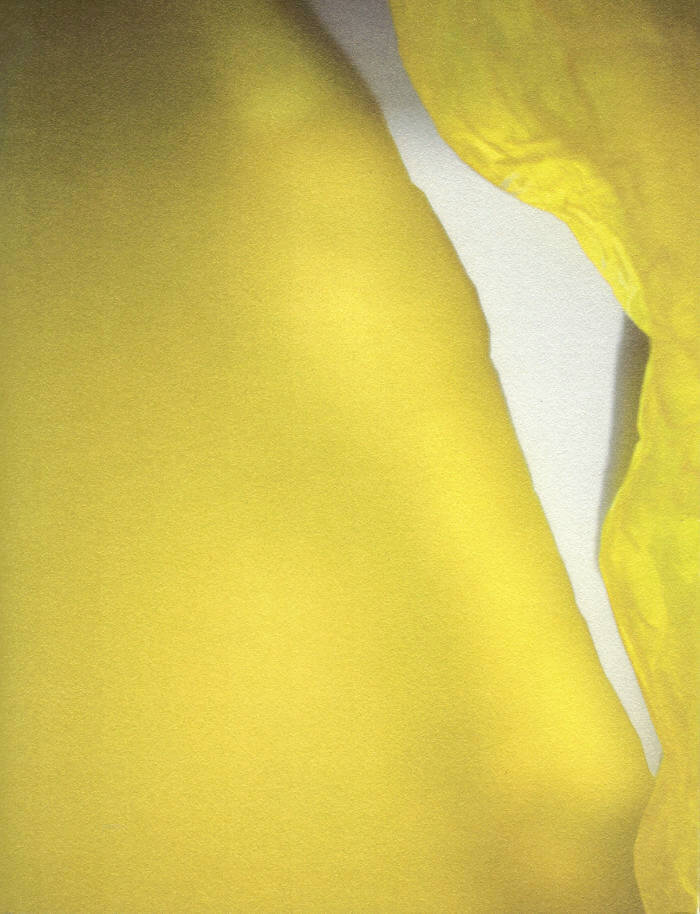
El Plástico, the Sun that lives inside the Rock
Viktorija Rybakova, Goda Budvytytė
This publication El Plástico, the Sun that lives inside the Rock is an observation on evolution of material plasticity, it is a story about plastic whose native land is Mesoamerica. It explores the past, present and future of plastic through encounters with various people — a weaver from Oaxaca, a taxi driver, a sociologist working on trash collection in Mexico City and the owner of a small family-run plastic factory. The book contains a polymorphous project resulting from several years of research by artist Viktorija Rybakova and designer Goda Budvytytė, it also includes a conversation between philosophers Kristupas Sabolius and Catherine Malabou, and essays by Post Brothers and Chris Fitzpatrick.
Editor: Goda Budvytytė and Viktorija Rybakova
Texts: Goda Budvytytė, Chris Fitzpatrick, Catherine Malabou, Post Brothers, Viktorija Rybakova, Kristupas Sabolius

The Artist Job Description, for the Employment of the Artist, as an Artist, Inside the Art Institution
“The artist’s experience of being inside art institutions, starting from the effort made to be accepted in order to develop one’s art practice, then the experience of going through them, and while in them, the many ways of having to learn how to be inside. This will in several ways inform the development of an artist’s practice, for the good or for the bad. Making this publication has been an attempt at recognizing and dealing with, rather than avoiding, the tensions that exist in the relationship between artists and art institutions at a time when most art institutions themselves are under the pressure of austerity-politics.”
The Artist Job Description, for the Employment of the Artist, as an Artist, Inside the Art Institutionconstitutes the result of Vijai Maia Patchineelam’s PhD research in the arts at the Royal Academy of Fine Arts Antwerp, University of Antwerp and a.pass, advance performance and scenography studies, Brussels.
Authors for the research seminar ‘Descriptions Change, The Artist Job Description: ADRIJANA GVOZDENOVIĆ, EVI OLDE RIKKERT, FELIX RAPP, JOEP VOSSEBELD, JULIA DAHEE HONG AND PIA LOUWERENS
Copy-editor for ‘The Artist Job Description, For the Employment of the Artist, as an Artist, Inside the Art Institution’: HEMANT SAREEN
Co-Editor for thickets: FABIEN SILVESTRE SUZOR
Proof-reader: SARAH PREDDY
Graphic design: NINA BAČUN AND ROBERTA BRATOVIĆ (OAZA, ZAGREB)
Printer: SVEUČILIŠNA TISKARA, ZAGREB
Edition: 400

Taming a Wild Tongue
Laura Cemin, Bianca Hisse and 1 more
Referring to Gloria Anzaldúa's notion of 'wild tongue' (Borderlands/ La Frontera, 1987), the publication departs from the questions: How to tame a wild tongue? How to carry language? The verbs 'taming' and 'carrying' imply certain dynamics of permission and restriction of movement, and suggest the entanglement between language and the body. The project delves into the notion of 'tonuge' as an archive: the 'tongue' as a muscle shaped by the physical practice of moving/ talking, having memory; the 'tongue' as a 'cultured' part of the body. It addresses accent as part of our linguistic identity, but also something that defines access or restriction. (From Monika Charkowska's preface to the publication)
Artists: Bianca Hisse, Laura Cemin
Curated by: Monika Charkowska
Texts by: Monika Charkowska, Claire Goodall, Kübra Gümüsay, Bianca Hisse, Laura Cemin
Edited by: Monika Charkowska
Translations: Epp Aareleid (ENG to EST), Ksenia Krimer (ENG to RUS), Keiu Krikmann (ENG to EST), Anita Kodanik (ENG to RUS)
English Proof-Reading: Epp Aareleid
Graphic Design: Kersti Heile
Edition of 200.